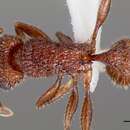fr
noms dans le fil d’Ariane


Taxonomic history
Combination in Tetramorium: Bolton, 1979 PDF: 161.Raised to species: Bolton, 1979 PDF: 161.(Figs 50, 51)
Xiphomyrmex spinosus subsp, hispidus Wheeler, 1915: 415. Syntype workers, U. S. A.: Arizona, desert E. of Tucson, 22. xi. 1910 (W. M. Wheeler) (USNM, Washington; MCZ, Cambridge; BMNH) [examined].
Worker. TL 3.9 - 4.5, HL 0.90 - 1.02, HW 0.84 - 0.94, CI 89 - 94, SL 0.68 - 0.82, SI 81 - 89, PW 0.64 - 0.74, AL 1.16 - 1.38 (30 measured).
Mandibles densely longitudinally striate. Frontal carinae strongly developed, sinuate, surmounted by a semitranslucent raised rim or flange which is highest behind the frontal lobes and gradually becomes lower posteriorly. Antennal scrobes narrow but capable of receiving the scape. Eyes both absolutely and relatively large, their maximum diameter 0.22 - 0.26, about 0.26 - 0.30 x HW. Propodeal spines short, stout and acute. Metapleural lobes varying in shape from a short, broad but acute triangle to a roundedtriangular lobe, never elongate-spiniform and often as broad or broader across the base than they are long. Dorsum of head longitudinally rugulose, the constituents spaced out and usually gently sinuate or irregular along their length, but not vermiculate. Reticular cross-meshes sparse or absent in front of the level of the posterior margins of the eyes but the occiput usually with a rugoreticulum. Dorsal alitrunk and petiole coarsely reticulate-rugose, the latter less strongly so than the former. Dorsum of postpetiole less strongly rugose than petiole but with more strongly developed punctulate sculpture between the rugae. Elsewhere dense punctulate sculpture is usually conspicuous on the head between the rugulae but is much weaker on the dorsal alitrunk. First gastral tergite with a basal band of dense punctulation or shagreening which may be faint in some individuals but apparently is never absent in this species. All dorsal surfaces of head and body with dense, short, bristly pilosity, the longest hairs on the alitrunk at most only approaching the maximum diameter of the eye and usually much shorter. Pilosity on leading edge of antennal scapes and dorsal (outer) surface of hind tibiae erect to subdecumbent, very short, less than half the maximum diameter of the appendage from which they arise. Colour varying from reddish yellow to deep red-brown.
Formerly treated as a subspecies of spinosum , the above series of diagnostic characters seem consistent and indicate that hispidum is best regarded as a valid species. The combination of large eye and short bristly pilosity is not repeated elsewhere in the complex and although some specimens of spinosum from Baja California approach hispidum in size of eye they have the elongate, less bristly pilosity characteristic of that species.
The punctulation or shagreening of the base of the first gastral tergite seen in this species is variable in density and intensity. In most samples it is coarse and distinct but occasionally it may be so faint as to be visible only under the correct lighting conditions.
Material examined.
U. S. A.: Texas, Langtry (W. M. Wheeler); Texas, Pesidio Co., Alamito (W. M. Wheeler); Arizona, Catalina Mts, Fenner Canyon (W. M. Wheeler); Arizona, Cochise Co., Portal (W. L. Brown); Arizona, Phoenix (L. C. Murphree); Arizona, nr Oracle (L. G. Werner); Arizona, Tucson (W. M. Wheeler); Arizona, Huachuca Mts, Miller Canyon; Arizona, Mesa (L. C. Murphree).
Tetramorium hispidum is a species of ant in the subfamily Myrmicinae.[1] Tetramorium hispidum differs from similar ants in the Myrmicinae subfamily by the structure surrounding the ant's antennal insertions. Short, stubble-like hairs exist on the pronotum and frontal carinae. The antenna of Tetramorium hispidum contains 11 segments.[2]
Tetramorium hispidum is a species of ant in the subfamily Myrmicinae. Tetramorium hispidum differs from similar ants in the Myrmicinae subfamily by the structure surrounding the ant's antennal insertions. Short, stubble-like hairs exist on the pronotum and frontal carinae. The antenna of Tetramorium hispidum contains 11 segments.


Tetramorium hispidum is een mierensoort uit de onderfamilie van de Myrmicinae.[1][2] De wetenschappelijke naam van de soort is voor het eerst geldig gepubliceerd in 1915 door Wheeler, W.M..
Bronnen, noten en/of referenties
Tetramorium hispidum (лат.) — вид мелких муравьёв рода Tetramorium из подсемейства Myrmicinae. Северная Америка (Мексика, США). Длина тела около 4 мм. Усики 11-члениковые. Глаза крупные, их максимальный диаметр равен или более 0,26 от ширины головы. Стебелёк между грудкой и брюшком состоит из двух члеников: петиолюса и постпетиолюса (последний четко отделен от брюшка), жало развито[1][2].

Tetramorium hispidum (лат.) — вид мелких муравьёв рода Tetramorium из подсемейства Myrmicinae. Северная Америка (Мексика, США). Длина тела около 4 мм. Усики 11-члениковые. Глаза крупные, их максимальный диаметр равен или более 0,26 от ширины головы. Стебелёк между грудкой и брюшком состоит из двух члеников: петиолюса и постпетиолюса (последний четко отделен от брюшка), жало развито.